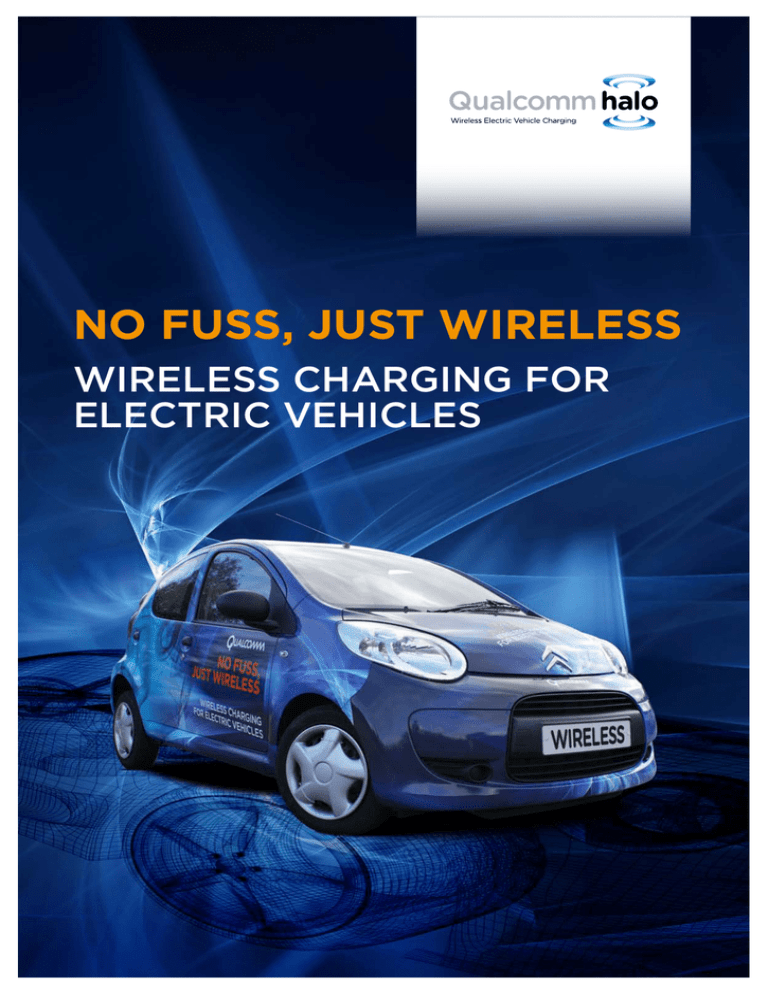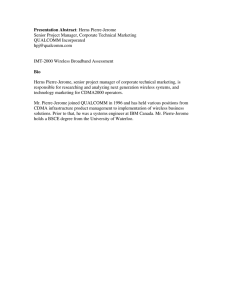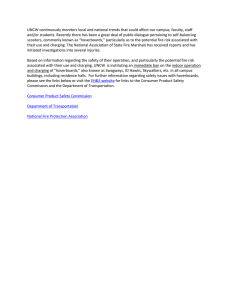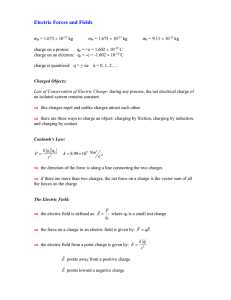
No Fuss, Just Wireless
Wireless charging for
electric vehicles
Qualcomm Halo Wireless Electric Vehicle Charging | No fuss, just wireless
Electric Vehicles set for growth
The use and acceptance of Electric Vehicles (EVs) amongst
businesses and consumers will become more prevalent, driven
by investment from the automotive and infrastructure industries.
Behind this growth, total cost of ownership
Qualcomm Halo believes that wireless
will be one of the key purchasing criteria, as
charging, which is simple and convenient, will
will the simplicity of charging. Qualcomm
eventually become the preferred charging
believes that the improved user experience
method for all EVs. That is why we are
delivered by wireless charging will enhance
developing our universal wireless charging
EV growth. Plug-in charging is far from simple;
technology that can be deployed in all
it is cumbersome, brings potential health,
geographic areas. Simplicity and minimum
safety and reliability issues, especially at
driver intervention are key features that win
street level, while public charging equipment
out time-and-time again, and we believe
is open to damage from the environment,
when these features are coupled with high
vandalism, and is visually unappealing.
power transfer efficiency, wireless charging
is a winning combination.
“It is relatively easy to muscle power across a gap
without any consideration of the consequences.
The real achievement is to understand the parameters
at play and transfer that power effortlessly...”
Nigel P. Cook. Principle Investigator, Qualcomm Wireless Power
2 Qualcomm Halo | Electric Vehicles
Qualcomm Halo Wireless Electric Vehicle Charging | No fuss, just wireless
Wireless electric vehicle charging vision
Our lives are becoming less and less about wires and cables and
more about wireless: from mobile phones, to the wireless Internet
and recently low power wireless charging for mobile phones.
Wireless power though is about
WEVC stationary charging is the near
One of those key criteria is that
to take a huge leap in scale, as
term future with ease and simplicity
charging must be effortless.
kilowatts can now be transferred
of electric vehicle charging; while
over an air gap of hundreds of
DEVC, Dynamic Electric Vehicle
millimeters while still maintaining
Charging, is the medium/long term
high-energy transfer efficiency.
vision of a totally no fuss wireless
Wireless Electric Vehicle Charging
electric vehicle charging society.
Qualcomm Halo WEVC technology
uses magnetic resonance to couple
power from the BCU to the VCU
that is part of the vehicle charging
system. Power is transferred to the
(WEVC), is a no fuss, simple solution
Inventive Steps
VCU pad via magnetic coupling and
for charging electric vehicles and
Inductive power has been around
this energy is used to charge the
hybrid electric vehicles. While
for over 100 years, and many people
vehicle’s batteries.
WEVC technology is ideally suited
today experience the unique physics
to stationary wireless charging,
of magnetic resonance when they
it also opens up the possibility
charge their electric toothbrush.
of dynamic wireless charging –
Qualcomm Halo has taken the
charging the electric vehicle battery
fundamentals of inductive power
while the vehicle is being driven.
transfer and by introducing several
The adoption of WEVC technology
will lead to a shift in charging
behavior. Drivers will charge their
electric vehicle little and often and
potentially use dynamic charging to
complement local stationary charging
removing range anxiety. This means
that batteries could be smaller with
the resulting reduction in electric
vehicle cost and vehicle weight.
3 Qualcomm Halo | Electric Vehicles
A Qualcomm Halo WEVC system
can also transfer energy from the
electric vehicle battery to the
electricity grid, in what is known as
Vehicle to Grid (V2G) charging.
inventive steps and technology
breakthroughs has developed
a solution that meets the key
criteria needed to grow the electric
vehicle market.
WEVC Technology Explained
Acronyms
WEVC
Wireless Electric
Vehicle Charging
DEVC
Dynamic Electric
Vehicle Charging
BCU
Base Charging Unit
– on or under the ground
VCU
Vehicle Charging Unit
– on the vehicle
EV
Electric Vehicle
PHEV
Plug-in Hybrid
Electric Vehicle
V2G
Vehicle to Grid
Qualcomm Halo Wireless Electric Vehicle Charging | No fuss, just wireless
Why wireless electric vehicle charging will win
The early experience from electric vehicle drivers is
that they generally charge overnight with very occasional
charging at public charging points.
Early adopters likely have easy
Electric vehicle drivers themselves
Dynamic Charging
access to a home charging point,
will also opt for the simplicity of
Charging an electric vehicle while
either in their garage or on their
wireless charging; no fuss and no
driving is the ultimate deployment
drive. The mass market though will
hassle from unwieldy, dirty cables
of WEVC technology. Dynamic
bring with them different charging
that are difficult to handle when
Charging removes the need for
needs. Many EV drivers will have to
it is cold and wet. In addition, we
constant charging stops, when
use street parking due to a lack of
believe many drivers would be wary
travelling long distances: in fact,
dedicated private parking spaces, in
of using plug-in cables in heavy rain
journeys of hundreds of miles/
city apartments for instance. Public
or when the car or charge point is
kilometers would be possible with
charging demand will therefore
covered in snow.
Dynamic Charging.
There is also a clear economical
Qualcomm Halo envisage a transport
benefit to wireless charging; keeping
system where licensed operators
Utilities and municipalities
the battery charge at between 40-80%
build out the Dynamic Charging
consequently have two options;
will optimize the life of the electric
network in a similar way to which
to deploy plug-in charging with
vehicle battery. Small top-up charging
wireless communications networks
an increase in street furniture, that
will therefore become the norm: at
have been deployed. Dynamic Electric
carries the risk of vandalism and the
home, at work, at the supermarket.
Vehicle Charging (DEVC) technology
loosening and oxidization of electric
Wireless charging lends itself
would be integrated into one or more
connections; or to deploy ground
perfectly to this kind of user
lanes of main roads and highways
based or below ground wireless
behavior. We think drivers would
and DEVC drivers would drive and
charging with no street clutter. This
not make the effort to plug-in and
charge at the same time. It really
also removes the health and safety
charge for 5-10 minutes, while a
would be that simple.
risk to the general public of tripping
wireless charging driver would do
and falling over high voltage cables.
so because of the simplicity of park
increase as electric vehicle
ownership expands.
and wireless top-up, especially if
coupled with fast authentication.
Qualcomm Halo expect new business
models to develop around DEVC
networks and services, potentially
mirroring the wireless communications
business models that have helped
drive global adoption of wireless
mobile phones and devices.
4 Qualcomm Halo | Electric Vehicles
Qualcomm Halo Wireless Electric Vehicle Charging | No fuss, just wireless
Business model & Qualcomm pedigree
The world leader in next-generation mobile and
wireless technologies, Qualcomm is no stranger
to the wireless charging space.
Business Model
There are two approaches to an
industry business model for wireless
electric vehicle charging; a
fragmented vertical model where
multiple companies vie for market
position based on a mostly
proprietary technology offering;
or alternatively, a horizontal model
where a common standardized
technology forms the basis for
multiple company wireless charging
solutions. Both business models
The validation of this model can be
Qualcomm Pedigree
seen in the extensive competition
The world leader in next-generation
in the markets that Qualcomm
mobile and wireless technologies,
operates in and the growth these
Qualcomm is no stranger to the
markets continue to experience. In
wireless charging space, having
addition, Qualcomm Halo participates
already developed technology and
in relevant standards bodies to
solutions for wirelessly charging
Qualcomm Halo’s business model is
help drive common standards that
mobile handsets and portable
horizontal; to aggregate Research and
foster a faster transition to new
consumer electronics devices.
Development (R&D) and transfer
technological advances.
offer technology innovation, which is
essential to drive market adoption,
but only a horizontal business model
can deliver keen market competition
and long-term economies of scale
to drive down costs.
technology from highly experienced
Qualcomm Halo technology is
It’s a win-win-win situation; for
based on years of investment
the auto manufacturers who get
including technical and commercial
competitive offers for a standards
development over the past two
based interoperable technology;
decades by The University of
for component suppliers who can
Auckland, an acknowledged pioneer
This business model is collaborative
innovate at a feature level while
in wireless power transfer. The result
and means that multiple companies
benefiting from industry-wide
is a robust Qualcomm Halo solution
can bring their own inventiveness to
R&D programs; and for customers
and a substantial patent portfolio
the table while enabling ecosystem
who get cost efficient wireless
covering inductive charging for both
partners to focus on their own core
charging and don’t have to worry
low power and high power systems.
competencies to develop unique
about the compatibility of wireless
product features and build total
charging points.
engineering support functions so
a broad range of licensees can be
confident in the technology and
products we provide.
system capabilities.
Qualcomm Halo | Electric Vehicles 5
Qualcomm Halo Wireless Electric Vehicle Charging | No fuss, just wireless
Standardization
Standards need to be at the heart of the
WEVC technology and ecosystem to drive
and accelerate industry growth.
Standardization leads the way to
low. Global open standards have
This ability to magnetically align the
a No Fuss, Just Wireless, charging
proven time and time again that
two charging pads becomes essential
customer experience that is vital for
high growth rates can be achieved
should dynamic charging become
customer adoption.
and sustained; and all players in the
one of the preferred charging
ecosystem can benefit financially
solutions for electric vehicles in the
from a standards-based approach to
future. A Qualcomm Halo dynamic
the electric vehicle charging industry.
charging network would still work
Charging has to be simple: all WEVC
Base Charging Units (BCU) and
Vehicle Charging Units (VCU) need
to be compatible so that customers
The Qualcomm Halo business model
do not have to search for a charging
is built around standards, technology
station that works with their
licensing, and continued innovation
particular vehicle charging system.
to support ecosystem development.
Ubiquity is a must: coverage is what
Alignment and Tolerance
drives adoption. The more charging
Qualcomm Halo WEVC technology
opportunity, at home, at the office, at
uses patented innovative
all the places we park, the more
technology that enables highly
confident customers will be about
efficient power transfer between
the electric vehicle driving experience.
the BCU and VCU even when the
Costs must be controlled: price is
key to create a global market for
WEVC and electric vehicle growth.
Proprietary and closed technologies
keep costs high and competition
Qualcomm Headquarters
5775 Morehouse Drive
San Diego, CA 92121
T: +1 858 587 1121
F: +1 858 658 2100
www.qualcomm.com
at high power transfer efficiency
even with the vehicle drifting across
the dynamic charging lane, typical
during normal driving.
Magnetic alignment is an inventive
step; an innovative breakthrough;
and it makes Qualcomm Halo
WEVC technology effortless to use.
charging pads are not completely
aligned. This makes parking simple
and easy for drivers who do not
need to park accurately in the
WEVC charging bay.
Qualcomm Europe
Building 4
Chiswick Park
566 Chiswick High Road
London W4 5YE. UK
T: +44 208 996 4100
F: +44 208 996 4170
www.wevc.com
E: wevc@qualcomm.com
© 2011 Qualcomm Incorporated. All rights reserved. QUALCOMM is a trademark of Qualcomm Incorporated, registered in the United States
and other countries. QUALCOMM HALO is a trademark of Qualcomm Incorporated. Other products or brand names may be trademarks
or registered trademarks of their respective owners. Qualcomm reserves the right to change any product specifications. Nothing in this
document is an offer to license or sell any of technology referenced herein.




